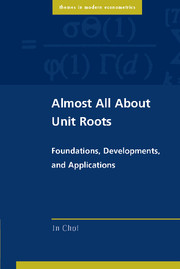Book contents
- Frontmatter
- Dedication
- Contents
- Foreword
- Preface
- Abbreviations and Notation
- 1 Introduction
- 2 Inference on Unit Roots: Basic Methods
- 3 Unit Root Tests under Various Model Specifications
- 4 Alternative Approaches to Inference on Unit Roots
- 5 Other Issues Related to Unit Roots
- 6 Seasonal Unit Roots
- 7 Panel Unit Roots
- Epilogue
- References
- Index
- Frontmatter
- Dedication
- Contents
- Foreword
- Preface
- Abbreviations and Notation
- 1 Introduction
- 2 Inference on Unit Roots: Basic Methods
- 3 Unit Root Tests under Various Model Specifications
- 4 Alternative Approaches to Inference on Unit Roots
- 5 Other Issues Related to Unit Roots
- 6 Seasonal Unit Roots
- 7 Panel Unit Roots
- Epilogue
- References
- Index
Summary
I have discussed research on unit roots conducted over the last few decades. It began with White (1958), but the related literature has grown to be immense and rich over the years. It is quite amazing that so many researchers have exerted their efforts to understand the problems related to unit roots. Why is it so, and how could this research effort be possible? There are several reasons. First, the models used for the literature on unit roots are simple. They are the AR(1) model and its extensions. It means that there is no entry barrier to understanding the models in use. If an individual has a new idea and is equipped with relevant techniques, he or she can readily work on a paper related to unit roots. Second, the literature on unit roots is empirically relevant. A large number of empirical papers using unit root tests and related methods have been written in economics and other branches of social science, and this trend is expected to continue. In fact, unit root tests have become a standard tool in time series analysis, as indicated by the numbers of citations of such papers as Dickey and Fuller (1979) and Phillips (1987a). The empirical relevance of unit roots has motivated many researchers to work on the related problems. Third, the functional central limit theory that Phillips (1986, 1987a) introduced to the literature made it possible to analyze various linear and nonlinear regression models without running into methodological difficulties. Equipped with the proper basic tool, researchers could develop their own theories in diverse directions, which expanded the literature on unit roots.
Regression analysis has a long history starting arguably from Galton's (1889) study on the relationship between children's and their parents’ heights. During its long history, however, no one could have imagined that the stochastic nature of regressors could fundamentally change the way regression results are interpreted until White (1958), Dickey and Fuller (1979), Phillips (1986, 1987a), Engle and Granger (1987), and others pointed it out.
- Type
- Chapter
- Information
- Almost All about Unit RootsFoundations, Developments, and Applications, pp. 223 - 224Publisher: Cambridge University PressPrint publication year: 2015

